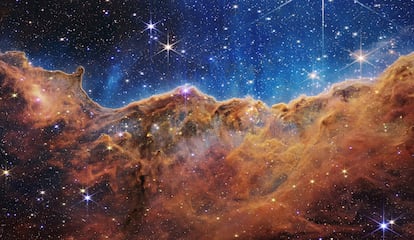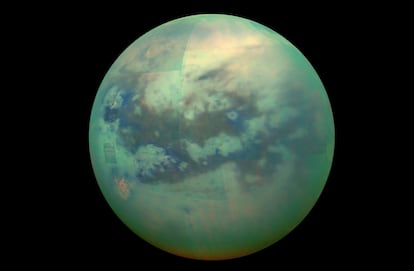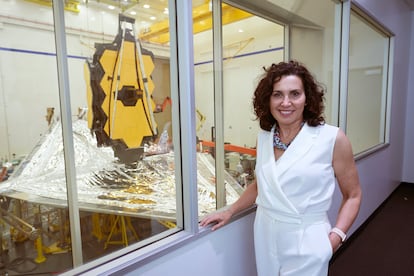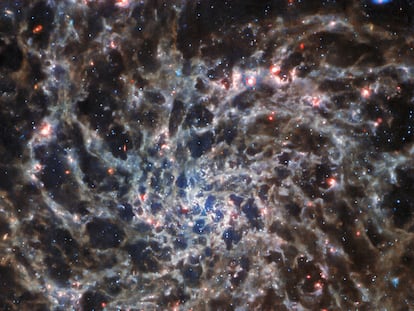James Webb Space Telescope: Atmosphere of excitement as astronomers study climate on other planets
Planetary experts think the probe could potentially discover clues to help answer the fundamental question of “Where do we come from?”

The James Webb Space Telescope (JWST) launched on Christmas Day 2021, is already transforming our understanding of planets in our Solar System and far beyond. A versatile satellite observatory, JWST has a clear-eyed view from its orbital position, one million miles away from Earth in space. This gives it a major advantage over ground-based telescopes, which must peer out to space through Earth’s hazy atmosphere.
JWST collects five times as much light as the Hubble Space Telescope (HST), allowing it to detect faint signals from distant worlds using its spectroscopic capabilities.
“Before the James Webb Space Telescope, only a very small number of molecules could be observed, such as water, carbon monoxide and sodium,” said Jérémy Leconte, astrophysicist at the University of Bordeaux in France.
Previous missions and observations from Earth have discovered thousands of exoplanets (those outside our Solar System) and astronomers are already taking advantage of JWST’s unique capabilities to study the building blocks of life in the Universe.
Alien skies
Earlier this year, the James Webb telescope allowed astrophysicists to observe an exoplanet around a Sun-like star, 700 light-years away. Starlight passing through the atmosphere of the hot Jupiter-like planet WASP-39b gives astronomers a view into the chemistry of alien skies.
From Earth, telescopes struggle to observe carbon dioxide on exoplanets, as they must look through the CO2 in the planets’ atmosphere. The JWST observatory allows a greater range of molecules, including carbon dioxide, to be detected in the skies of WASP-39b. The presence of carbon dioxide in the atmosphere may indicate organic life exists on the planet.

“This is really a game-changer,” said Leconte. “We really need to look at planets around stars that are close to us. This is our best chance to characterize their atmospheres.”
In particular, he is interested in seven rocky planets that orbit the dwarf TRAPPIST-1 star, 40 light-years away, and especially their atmospheres. The planets exist in the habitable zone, meaning it has the right temperatures for water to remain liquid.
Usually, when scientists make predictions about an exoplanet’s atmosphere, they assume it is homogeneous – the same conditions exist all over it. This is unlikely to be true.
Leconte has developed a 3D simulator (as part of the Horizon-funded WHIPLASH project) to run tests on simulated planets with known characteristics, such as the presence of liquid water. Using simulated planets to run these tests is like having the answers at the back of a math’s book: tests can be run and the answers the models provide can be compared with the known characteristics.
Many thousands more exoplanets will likely be discovered in the coming years – including those found using the new space telescope. Scientists want to know if their models can offer accurate insights. Some of the answers to questions about far-away exoplanets might lie close to home in the Solar System, in the four largest planets – Jupiter, Saturn, Uranus and Neptune.
The Juno orbiter mission has provided spectacular views of Jupiter, while the Cassini spacecraft revealed details about the planet Saturn. Previously, the Voyager 2 spacecraft flying by Neptune and Uranus took images of their atmospheres.
“We have captured glorious images from these planets, with all these whirling storm systems and candy-coloured stripes, which are large-scale weather circulation patterns,” said planetary scientist Leigh Fletcher at the University of Leicester. “But it is just a snapshot of their atmospheres and climates at a particular moment in time.”

Four giants
To understand climate and weather patterns, Fletcher leads a project called GIANTCLIMES that pieced together scattered pieces of the puzzle of their ever-changing atmospheres. They used past observations from telescopes on Earth to understand natural cycles on the four giant planets over many decades. This work has prepared the ground for the highly anticipated new maps of these worlds from the JWST.
Uranus and Neptune are the most distant planets in the Solar System, and these so-called “ice giants” still retain an air of mystery. They are composed mostly of hydrogen, helium and other gases like methane.
“There’s so much potential for brand new discoveries [with these two planets],” said Fletcher. “We don’t have a good handle on the workings of the atmospheres of these ice giants compared to the better-studied gas giants [Jupiter and Saturn].”

Methane snow
Meanwhile, Saturn is known to have massive storm systems, and Neptune may have methane snowstorms. The key variable in weather patterns is always temperature, with frigid cold temperatures on distant Neptune and Uranus.
There has been progress already with the publication of the first ever maps of atmospheric temperatures high in the stratosphere of Uranus. This revealed surprising seasonal circulation systems and bright spots over the poles.
It also predicts that giant planets, often titled on their axis, have extremely long seasons. “We do see seasons modulating atmospheric temperatures and clouds and precipitations as we do on planet Earth,” said Fletcher, “but we also see regular natural cycles in the atmosphere that are not seasonal. We’re just starting to understand the weather on giant planets.”
Also, Neptune’s atmosphere showed substantial storm and weather activity, but the team were surprised with the finding that the planet seems to have cooled during the summer, rather than warmed.
GIANTCLIMES is a supporting act for the arrival of the JWST. The new telescope has already observed Jupiter, and in the near future it will turn towards Uranus and Saturn, and then Neptune early in 2023, allowing for comparisons between planets.
“How the climates work on the four worlds is really the nub of what we are trying to understand,” said Fletcher. It is expected to offer more insight into the natural cycles of climate variability as detected on Jupiter, Saturn, Uranus and Neptune. Their extremes could even tell us more about Earth’s own climate and weather patterns.

Alien life
Studies of the four giants are also relevant to exoplanet research. “We’ve got a collection of diverse planetary atmospheres in our Solar System which form a template for what we might expect to see around other stars,” enthused Fletcher.
“Maybe these exoplanetary targets also exhibit similar natural cycles, and the end goal is to try to have weather prediction or climate prediction for all of the planets, not just those in our Solar System,” concluded Fletcher.
JWST will allow scientists better views into the skies of planets in the far reaches of the Solar System, but also worlds light years away, some of which could be surrounded by protective atmospheres and terrestrial conditions conducive to alien life.
“Two fields are moving fast in astrophysics. They are exoplanets and cosmology, which really comes down to the question of God and life, so where does the Universe come from and where do we come from,” said Leconte.
Research in this article was funded via the EU’s European Research Council (ERC). The article was originally published in Horizon, the EU Research and Innovation Magazine.
Tu suscripción se está usando en otro dispositivo
¿Quieres añadir otro usuario a tu suscripción?
Si continúas leyendo en este dispositivo, no se podrá leer en el otro.
FlechaTu suscripción se está usando en otro dispositivo y solo puedes acceder a EL PAÍS desde un dispositivo a la vez.
Si quieres compartir tu cuenta, cambia tu suscripción a la modalidad Premium, así podrás añadir otro usuario. Cada uno accederá con su propia cuenta de email, lo que os permitirá personalizar vuestra experiencia en EL PAÍS.
¿Tienes una suscripción de empresa? Accede aquí para contratar más cuentas.
En el caso de no saber quién está usando tu cuenta, te recomendamos cambiar tu contraseña aquí.
Si decides continuar compartiendo tu cuenta, este mensaje se mostrará en tu dispositivo y en el de la otra persona que está usando tu cuenta de forma indefinida, afectando a tu experiencia de lectura. Puedes consultar aquí los términos y condiciones de la suscripción digital.
More information
Archived In
Últimas noticias
David Bowie, the galactic thinker who encouraged us to break new ground
John Berger and the loss of rural culture
From police officer to bloodthirsty kidnapper: Terror in Mexico during the years of ‘The Ear Chopper’
Alain Aspect, Nobel laureate in physics: ‘Einstein was so smart that he would have had to recognize quantum entanglement’
Most viewed
- David King, chemist: ‘There are scientists studying how to cool the planet; nobody should stop these experiments from happening’
- Reinhard Genzel, Nobel laureate in physics: ‘One-minute videos will never give you the truth’
- Oona Chaplin: ‘I told James Cameron that I was living in a treehouse and starting a permaculture project with a friend’
- Mexico completes its trade shift with the entry into force of tariffs on China and countries without trade agreements
- Sinaloa Cartel war is taking its toll on Los Chapitos










































